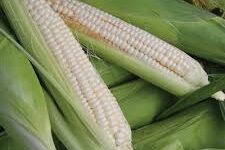Sweetcorn
Sweet corn (Zea mays convar. saccharata var. rugosa), distinct from field corn, is grown for its tender, sweet kernels that are consumed as a vegetable. It’s a popular crop in many parts of the world due to its taste, nutritional value, and versatility in cooking. Here’s an overview of sweet corn cultivation, including varieties, planting, care, and harvesting:
Varieties
Sweet corn comes in several types, each with unique characteristics:
Sugary (su): Traditional variety with a high sugar content that converts to starch quickly after harvest.
Sugary Enhanced (se): Has more tender kernels and a longer shelf life than su varieties.
Supersweet (sh2): Contains two to three times more sugar than su types, with a crisp texture and longer shelf life.
Synergistic (sy): Combines su and sh2 genes, offering sweetness, creamy texture, and good shelf life.
Planting
Timing: Plant sweet corn after the last frost when soil temperatures reach at least 55°F (13°C). Sweet corn is a warm-season crop sensitive to frost.
Soil: Prefers well-drained, fertile soil with a pH of 5.5 to 7.0. Work in plenty of compost or aged manure before planting to improve fertility.
Method: Sow seeds 1 to 2 inches deep, spacing them about 9 to 12 inches apart in rows. Rows should be spaced 30 to 36 inches apart to allow for easy cultivation and pollination.
Watering: Sweet corn requires consistent moisture, especially during germination, flowering, and ear development. Avoid overhead watering to minimize disease risk.
Care
Fertilization: Apply a balanced fertilizer at planting and side-dress when the plants are about knee-high. Sweet corn is a heavy feeder, especially needing nitrogen.
Weeding: Keep the area around the plants free of weeds, which compete for nutrients and water.
Pest and Disease Management: Monitor for common pests like corn earworm and diseases such as rust or smut. Use appropriate cultural or chemical controls as needed.
Pollination
Sweet corn relies on wind for pollination, so it’s best planted in blocks of at least four rows rather than in single rows to ensure adequate pollination.
Harvesting
Timing: Harvest sweet corn when the kernels are full and milky, typically 18 to 24 days after the first silk strands appear. The silk should be brown, but the husks green.
Method: Pull the ear downward and twist to remove from the stalk.
Challenges
Sweet corn cultivation faces challenges such as bird and insect pests, water stress, and the need for timely harvesting to capture the peak sweetness of the kernels.
Uses
Sweet corn is enjoyed fresh, canned, or frozen. It’s a versatile vegetable that can be boiled, grilled, roasted, or used in salads, soups, and a variety of dishes.
Market
The market for sweet corn includes fresh markets, roadside stands, farmers’ markets, and processing industries for canned and frozen products. It’s a popular crop for both commercial farmers and home gardeners.
Sweet corn’s popularity stems from its sweetness and nutritional content, including fibers, vitamins, and minerals. Successful cultivation requires attention to planting timing, soil conditions, moisture, and pest management to ensure a productive harvest.
Showing all 2 results


